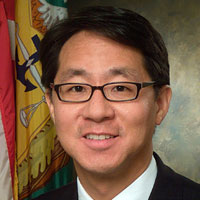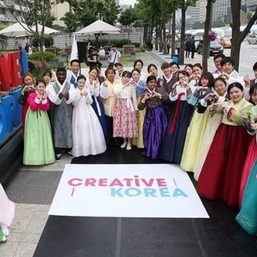SUMMARY
This is AI generated summarization, which may have errors. For context, always refer to the full article.

NEW YORK, USA – An old Japanese wartime propaganda poster from the Philippines now on display at a small, but powerful exhibition in New York City marking the 75th anniversary of the outbreak of World War II – at least from a US perspective – is striking, particularly In the context of the continued economic and military rise of China.
Beware and be wary, though, could well be the takeaway message, of words of peace during times of rising conflict.
As the sixth meeting of the US-China Strategic and Economic Dialogue (S&ED) took place July 9-10 in Beijing with US Secretary of State John Kerry and Treasury Secretary Jacob Lew representing the United States, and State Councilor Yang Jiechi and Vice Premier Wang Yang representing China, here’s a troubling question for the Philippines and other Asian nations to keep in mind: Does “New China” equal “Old Japan”? Or more pointedly, does China risk becoming the Japan of some seven decades past, namely a rising nation that sparks conflict and then war under the guise of “Asia for Asians”?
Let’s hope not, but the thought did occur in viewing the poster which depicts parts of east and southeast Asia, and in English, reads: “December 8th. The third anniversary of Greater East Asia War to defend Asia for and by the Asiatics. Japan’s victory is the Philippines Triumph.”
December 8th being, of course, the date from Asia’s side of the dateline of Japan’s attack on U.S. forces at Pearl Harbor, Hawaii.
On display at the Grolier Club, a New York institution dedicated to appreciation of books and prints, the poster is one of many items that can be viewed until August 2nd in “The Power of Words and Images in a World at War.” Drawn from the collection of the Museum of World War II in Boston, the exhibition focuses on the iconic posters, broadsides, books and periodical that influenced millions in the course of the “last great worldwide conflict.”
Recent protests in Hong Kong and Taiwan related to mainland China are not on the formal agenda of the S&ED talks, but they and Chinese maritime moves are likely to cast a shadow on the talks, which since 2009, have provided a platform for US-China discussion on bilateral, regional and global opportunities and challenges. Trouble is brewing in the East China and South China seas, where an increasingly assertive China, is seen, fairly or not, by many of its neighbors as a schoolyard bully, taking by force – one “salami slice” of territory at a time – what it could not through diplomacy.
The stationing of a massive floating deep-water oil rig by China into waters also claimed by Vietnam has been the latest flashpoint and tensions continue to escalate. Riots flared in Vietnam against factories and other interests perceived as being linked to China, and video footage of what seems to be a massive Chinese ship ramming and sinking a much smaller Vietnamese fishing boat has hit the Internet.
The last few weeks, let alone years, are no model for a way forward when it comes to dispute resolution.
Cases in point: In November of last year, China unilaterally announced an expanded air defense zone encompassing airspace that overlapped with claims by Japan, South Korea and Taiwan. And in the last few months, Chinese military planes have come dangerously close to those of the United States and Japan. China, Taiwan and Japan also all claim the Senkaku Islands, known as the Diaoyu Islands by the Chinese.
To the south, in an area that China claims is all its own, within a “nine-dash line” skirting the coasts of several Southeast Asian nation, Chinese ships now patrol a reef still claimed by and known by the Philippines as the Scarborough Shoal.
So far, China – in its rhetoric and its efforts to change the status quo – is losing the external public relations war even as its actions no doubt may play well at home amidst a slowing economy and growing concerns over pollution and corruption.
Asian security concept
Pointedly, at the recent Conference on Interaction and Confidence Building Measures in Asia (CICA) summit in Shanghai, Chinese President Xi Jinping unveiled a new “Asian Security concept,” which in essence called for Asian security to be left to Asians. China has indeed “stood up,” and a century of “humiliation” at the hands of western powers is long over, as China, the second largest economy in the world, resumes its “rightful” place in the world order.
Flash back to the 1930s and 1940s as imperial Japan’s propaganda machine exhorted Asians’ to control their own destinies and throw aside the yoke of western colonial rule. Asia for Asians was the mantra. And better yet, Japan’s leaders argued, come join Japan in a “Greater East Asia Co-Prosperity Sphere,” where all would benefit as Japan took its rightful leadership role in the region.
Well, we all know how well that played out, as Japan’s vision of Asia for Asians led that nation and much of the Asia-Pacific region down a path to destruction. From the ashes of World War II and the Korean and Vietnam wars that followed, a new paradigm evolved with the United States helping guarantee a Pacific peace that has allowed Asia to prosper and ironically China to rise. It is that defense status quo now being challenged by China even as the United States and Japan seek to reaffirm it.
At the Asia Security Summit held recently in Singapore, also known as the Shangri-La Dialogue, US Secretary of Defense Chuck Hagel and Japan Prime Minister Shinzo Abe both raised China’s ire with statements challenging China’s recent territorial moves.
The United States “will not look the other way when fundamental principles of the international order are being challenged,” Hagel said. “We firmly oppose any nation’s use of intimidation, coercion or the threat of force to assert [its] claims.” Abe, in his keynote address, announced Japan’s intention to play a greater role in regional security, in ensuring open skies and sea-lanes, and in supporting Southeast Asian nations in territorial disputes with China.
The potential for continued conflict remains.
Sadly, there is no third party – no respected principal on the school yard – to intervene, and in a face-saving move make clear that all sides need to let cooler heads prevail. China has now removed oil rig, and should think twice before and refrain from sending it back – a move that would no doubt spark further unrest. ASEAN must work together now, and a clear code of conduct be established in the South China Sea even as territorial claims remain unresolved. And every nation, Japan, China and the United States included, should treat each other with respect.
With tensions mounting, it is time for all players to take a step back from the brink of even greater conflict and commit to engagement, cooperation and a peaceful resolution to disputes. This will be essential if this century is to be one of shared peace and prosperity for the Philipines and the rest of the Asia-Pacific region. – Rappler.com
Curtis S. Chin, a former US Ambassador to the Asian Development Bank (under Presidents George W. Bush and Barack Obama), is managing director of advisory firm RiverPeak Group, LLC. Follow Curtis on Twitter at @CurtisSChin
Add a comment
How does this make you feel?

















There are no comments yet. Add your comment to start the conversation.